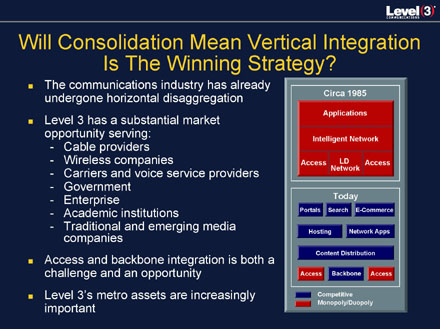Incumbent Schizophrenia: Lessons Learned from KPNs 1992-93 IP Backbone
June 6th, 2007 by Gordon Cook
Hendrik Rood is one of 12 list members from the Netherlands. His comments fascinate and this one provides some very interesting insight into the behavior of incumbents. This morning, referring to an earlier comment he wrote:
“This remark reminds me of the first IP backbone I developed in 1992-3. When I worked at Dutch incumbent KPN.
The backbone was for the Network Management System for a leased line infrastructure and consisted of a Cabletron Spectrum system communicating to Cabletron hubs with some 3rd party cards in it. It contained a Unix-blade that that ran a SNMP proxy converting proprietary (so-called Q2-) interfaces to the network termination devices (an 64k, 128k and 2 Mbit/s symmetric (H)DSL) and Router-cards from a tiny company, called Cisco … We built it together with CBIS (Cincinatti Bell Information Systems).
I only discovered in 1995, when I started working for Stratix, that this internal IP backbone of KPN was larger than the then national backbones of SURFnet (Education NREN) or Nlnet (Now Verizon Business).
It probably also carried more load. I drew several lessons from it.
Lesson 1: When incumbents have to do internal judgement only, they were very well able to choose optimal technologies for themselves.
Lesson 2: There are some weird processes at work inside marketing departments that made them continuing promoting technologies like X.400 and X.25 to the outside world and refute offering TCP/IP, when at the same time the internal IT departments, Network division and R&D labs were all already installing and operating networks based on TCP/IP.
Lesson 3: When taking the internal investor perspective throwing bandwidth at the problem was definitely the way to go.
The project director (a former division CTO, quite influential) had to push it through the districts throat, his main argument: “Anyone that can afford a 64 kbit/s leased line today at current prices, will be able to afford a 155 Mbit/s at then end of the projects date (it had a roll-out scheme of 7 year, as it was a complete overhaul and replacement project).
With respect to ATM we had shelved that in 1991 until at the end of 1993 SURFnet came asking for it. Also in our R&D lab a researcher Richard de Vries, had developed GAUSS [Grab Any Unused Slot Switch] the only non-American switch architecture I found described in Craig Partridge Gigabit Networking book.
We did deploy on a limited scle DQDB and FDDI on fiber networks, but they had the obvious ring architecture problems. The best selling item in the high end then was the ADC Magnum (3 x 10 Mbit/s Ethernet and some TDM through a proprietary multiplexer and 34 or 45 Mbit/s line system) which we hooked up for corporate customers on “tacitly sold” dark fiber links. Formally dark fiber was against policy, but it was allowed as there was no practical alternative.
When someone today observes “lightpath” backbones with multiple Gigabit Ethernets running through 10 Gbit/s SONET/SDH systems or devices like the ADVA systems or Barrolo of Cisco, this looks tremendously like a built out ADC Magnum to me. There is less new under the sun, than most imagine.
The issue has never been that inside telco’s there were no people who “did get it”. The issue was they bounced often into “official policies” even when they had a high-ranking position. And then had to force it through, an effort most were not succeeding in.
In 1992/1993 the main commercial paradigm in wide area networking at that time was still about X.25 & OSI, IBM SNA traffic and discussions about carrying IPX (Novell) network traffic and something about networks for Lotus Notes.
The weird thing was thus that major internal divisions already ate very different dogfood (TCP/IP) in 1993, and at a huge scale, than the marketeers thought the market really wanted …
It is this internal intellectual disconnect that hampers most incumbents.”
Hendrik





